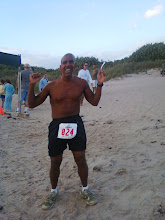Using your heart rate as a measure of fitness is used in various physical activities as a guide. While there may be a goal number the pulse itself isn't especially a goal but rather how it relates to your training. Let me explain.
Heart rate training is essentially a guide in your training much like other guides such as pace during swimming or amount of weight lifted. It's generally used to see your progress in your training. So how can it be used?
This type of training was first used by endurance athletes , especially tri athletes, but now it's used by many people for a variety of activities. Usually a person wears a heart rate monitor, either around the chest or the bicep. There are some watches that also measure your pulse as well as some machines have pulse measurements ( treadmills, bikes, rowers, elliptical) although they're usually not as accurate.
While monitoring your pulse is useful if you don't it's not the end of the world. And in some strength , anaerobic or low intensity activities, such as balancing on the bosu ball or push ups or even hitting the heavy bag all out for 3:00 ( 1 round) it really isn't useful to measure your pulse because the effort and the time spent is too short. Generally, it's best to do about 10:00 at least of moderate - high intensity activities non stop or almost non stop before measuring your pulse.
Pulse is also often used in the morning by many athletes to see if they've recovered from the
previous day's workout & overall whether you're fitness is improving or not. Generally, almost first thing in the morning after you wake up you would take your pulse and hopefully your resting pulse will be relatively low.
In the past the formula for finding your maximum heart rate was 220 - your age but that has been shown to not really be accurate, partly due to genetics as well as differences in lifestyle.
New methods for measuring your maximum pulse have been devised. Also important is zone training. These are the different percentages of your maximum pulse you want to train in depending on your goals. For most people training around 60 % of your maximum heart rate , building up to 85 + % near the end is a good idea. For advanced athletes, especially endurance athletes , you'd want to train occasionally around 85 % - 95 + % of your maximal heart rate for half an hour up to an hour. This is good for long distance runners, tri athletes,etc. Of course build up to it very carefully.
And another important factor, is perceived training effort vs actual heart rate. This is very important for competitive athletes. Essentially how do you feel on a scale of 1 - 10? Can you maintain a conversation or are you gasping for air? Most of your training, regardless of whether you're a beginner or advanced, will be easy. However in order to improve your speed and performance,
threshold training at very high race like intensity is a must. Obviously not every day but once or twice a week could provide great benefits. What type of threshold training you do will depend on your activity ( a runner might do track repeats, a swimmer might do laps,etc). For the general public high intensity intervals don't have to be running, it could be
body weight or resistance exercises. Plyometric style workouts are an example .You get the idea. I'm not giving specific workouts in this post because that's not what this post is about. As I've said , it depends on your goals, activities and fitness level. And of course start slowly, especially if you're a beginner, build carefully and check with your doctor first.
As for devices there are millions out there. They range from cheap to very expensive so look at what you can afford. For triathletes , if you can afford it,
consider Garmin , Apple & Polar. I personally use a
Garmin 920 XT. It shows pace, heart rate, cadence,etc. For most people you can find cheaper sports watches that measure often through a fingertip pulse ( I had such a watch several years ago). Of course it won't be as accurate. Just see what your needs are.Another possibility before your workout and especially in the morning is a blood pressure monitor along with pulse measurement. Such devices measure your vitals with a strap around your brachial pulse ( bicep). Unfortunately obviously you can't work out with it on! And often times after a sweaty workout these machines may not give an accurate number. Or you could just use a simple wrist watch or clock after you're done or resting. With 2 fingers just press your
radial pulse or carotid pulse. and count for anywhere from :10 - 1:00.
I hope this post has been helpful and will give you the info needed in order to improve your performance and reach your goals.
If you liked this post click like, subscribe and spread the word. And if you have a performance/fitness question feel free to email me
at mbrls2000@yahoo.com.


